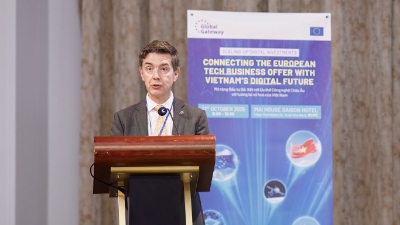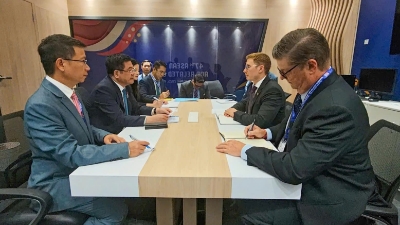When the world was gripped by the Covid-19 pandemic in 2020, South Korea was one of the first to set an example, with an almost-immediate response. It ramped up its testing capacities within a week of its first detected case in January and was producing 100,000 testing kits a day by April.
By September that year, it had 599 screening stations in hospitals, airports, and other strategic locations. Prioritizing detection and prevention allowed the country to “flatten the Covid curve” without bringing its economy to a complete halt.
While Covid was an unprecedented emergency, there have been other instances indicating that even long-term healthcare strategies can benefit from a focus on early diagnosis. Several studies show that there may be links between delayed diagnosis and increased mortality, including for diseases such as AIDS and tuberculosis.
This is a good direction for Vietnam’s healthcare system, which often faces challenges from the under-diagnosis and under-treatment of a broad variety of illnesses. Much of this can be attributed to a lack of medical professionals proportionate to the population.
According to the latest figures from the World Health Organization (WHO), the country has 0.8 doctors per 1,000 people, compared to the recommended ratio of 1:1,000. This shortage affects the availability of healthcare professionals to provide a first line of advice to communities.
This is where AI technologies can bring a marked shift by helping the sector work around these constraints.
Globally, we are witnessing how AI technologies in sectors such as banking and education can help reduce the administrative burden and complement human capacity. In healthcare too, early diagnostic technologies powered by AI can reduce reliance on extensive human intervention and help reach a wider group of people in a quicker timeframe. In Vietnam, however, investments in AI have been modest compared to other Southeast Asian countries such as Singapore, Indonesia, Thailand, and Malaysia.

AI can help diagnostics
AI-powered devices can strengthen last mile delivery for diagnostic services. For instance, mammograms have been instrumental in helping detect breast cancer early - but often fail to reach rural or low-income populations because the machines are heavy to transport and require substantial electrical power.
They also tend to be intimidating for women who do not feel comfortable undergoing the screening in a clinical setting. In such cases, hand-held screening devices aided by AI are fast proving to be a useful substitute that can cover the last mile.
Secondly, it can support capacity building for a diverse range of professionals who may be involved in healthcare work but are not medically qualified to make diagnoses. This includes community health workers, for instance, who would be able to provide primary care services with support of these mobile and easy-to-use devices.
Cutting-edge innovations like LLMs can further push the possibilities
We are seeing some of the most cutting-edge innovations in AI and healthcare coming from large language models (LLMs). Google’s med-PaLM2, perhaps the most well-known such model, is being tested by private healthcare providers in the US. Trained on medical data, the model can answer patient questions as well as preliminarily scan X-rays and other images.
The possibilities of LLMs in early diagnoses should not be wrongly imagined as the equivalent of receiving diagnoses from a chatbot or elevated search engine. Rather, truly innovative solutions can come from combining LLMs with propriety medical knowledge.
Simply put, this would mean integrating the generative technology with individual healthcare professionals’ medical opinions. In such a model, the diagnosis would be a combination of established medical facts and that particular medic’s approach to treatment.
Moreover, private individual ownership would ensure accountability, just as with physical consultations, and consequently uphold the quality and rigor of the medical advice.
Private capital can catalyze the transformation
To realize the potential of AI in diagnostics, we need to bridge the gap that exists in public spending. While Vietnam spends more on healthcare - 4.6 per cent of its GDP - than Malaysia, Thailand, Indonesia, and other comparable countries, most of this is focused on material needs such as infrastructure and supplies.
This creates an opportunity for private players, including philanthropies, to step in and prioritize transformative solutions such as AI in healthcare. It is useful to note that philanthropic investments have a higher risk appetite and are therefore well-placed to infuse the sector with the funding required for innovative solutions.
Moreover, philanthropic players can help bring in relevant expertise and networks at a scale and pace that would be difficult to achieve through public funds. For instance, the US-based Chan Zuckerberg Initiative plans to launch an ambitious computing system to “cure, prevent, or manage all disease by the end of the century.”
The system would provide scientists access to AI-aided predictive models for healthy and pathological cells with the aim of accelerating medical research. Through public messaging and outreach, philanthropic actors can also help speed up the deployment and adoption of AI diagnostic technologies, particularly among underserved populations.
Early and timely diagnosis is the largest lever for better mortality and morbidity outcomes along with reduced pressure on healthcare centers. These investments in building robust early diagnostic services are crucial - not just in addressing capacity constraints in the short term, but in raising the overall quality of healthcare in the long run.
Furthermore, with additional resources at their disposal, healthcare players can then channel their efforts towards research and development, helping Vietnam build a competitive and competent healthcare system that is reflective of the country’s dynamic growth.









 Google translate
Google translate